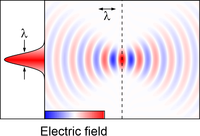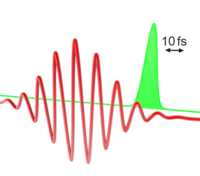Van der Waals materials
Van der Waals materials
Van der Waals quantum materials represent a versatile material platform with applicatons in energy harvesting, sensing, and nanophotonics.
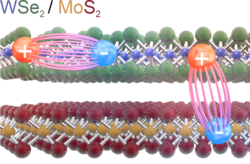 | Transition metal dichalcogenides The atomically thin nature of monolayers of transition metal dichalcogenides, such as MoS2 or WSe2, renders these two-dimensional sheets extremely susceptible to their environment. In addition, the weak dielectric screening leads to strong Coulomb attraction between electrons (blue) and holes (red). Bound states, so-called excitons, with binding energies of hundreds of meV emerge. These excitons dominate the optical response of monolayer transition metal dichalcogenides [6]. | |
| Their properties can be tuned by interlayer coupling [7], the twist angle [8], or the dielectric environment [9]. On ultrafast time scales, excitons may be spatially separated across a van der Waals interface, which affects their life time and binding energy substantially [10].
| ||
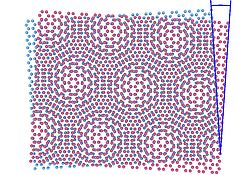 | Moiré superlattices When stacking two monolayers on top of each other with a twist angle or a lattice mismatch, the lattices interfere with each other. The emerging, larger-scale superlattice is typically referred to as a moiré pattern. Electrons experience this periodic modulation of the atomic registry as a potential landscape, which has several consequences. For instance, excitons may get trapped in the moiré potential. Furthermore, the electron-electron interaction can be strongly enhanced, leading to pronounced correlations that induce phase transitions. We want to resolve these and related exciting phenomena directly in space and time. | |
Hybrid light-matter modes
Hybrid light-matter modes
Polaritons are comprised of light and matter excitations, such as phonons and plasmons. These modes are often strongly localized to interfaces and feature wavevectors that exceed those of free-space electromagnetic radiation by up to two orders of magnitude. This strong confinement and the resulting enhancement of electromagnetic fields renders polaritons promising for nanophotonic circuits and applications in sensing and subdiffractional optics.
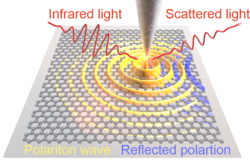 | Nano-optical imaging of The evanescent fields at the apex of the near-field tip can bridge the momentum mismatch and launch polariton waves. This approach has widely been used to image interference patterns of polariton waves in van der Waals crystals [11]. Thin slabs of van der Waals crystals may also act as waveguides [12,13] for infrared radiation. In this case, the polaritons propagate through the volume and are not confined to the surface. | |
 | Controlling polariton dispersion For future applications, a high level of control over the propagation of polaritons is desirable. Femtosecond photo-excitation has facilitated the ultrafast switching of polariton waves [4]. We aim to further introduce a subcycle detection of the wavefronts. For additional degrees of control, we want to rely on exotic material properties similar to the twist-tunable elliptical/hyperbolic dispersion in MoO3. | |

